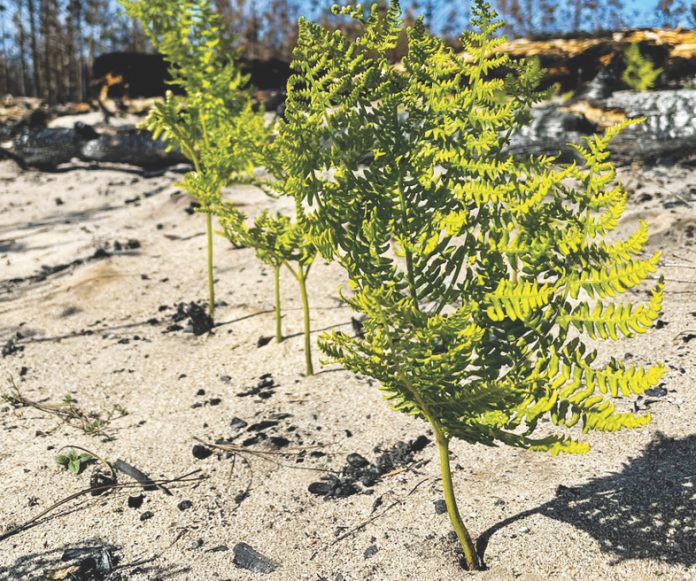The scorched earth left behind by the CZU Lightning Complex fires won’t stay barren for long.
That’s according to Amy Patten, who manages the Rare Plant Treasure Hunt project at the California Native Plant Society (CNPS).
“There is a lot of magic happening beneath the surface,” said Amy Patten on a live webinar while describing the barren “burn scars” charred into the Santa Cruz Mountains last summer.
Many of the places lost to the inferno will not be the same, she acknowledged, but below the ashes, new life is taking root.
Her talk, hosted through the Santa Cruz Museum of Natural History, was the beginning of a new community science project. The museum and the Kenneth S. Norris Center for Natural History at UC Santa Cruz recently joined with CNPS to design the initiative, called the CZU Lightning Complex and Community Science Project. The goal is to teach volunteers to identify and log species observations on the free app iNaturalist. Researchers can then use those observations to improve our understanding of post-fire ecosystems.
The project follows a larger CNPS effort to monitor burn areas across the state. The local organizers plan to host free online and in-person trainings a few times a month and hope to continue the work for years to come.
“Tracking succession over the next couple of years will be important,” Patten said. “There’s some short-lived annuals we might only see for the first year or two after the fire, but then other things won’t start to come back until next year or the year after.”
She’s particularly eager to see a rare, bright purple flower called the Santa Cruz Mountains beardtongue.
“We could see some crazy stuff that hasn’t been seen in the area in a long time, or maybe has never been documented here before,” she said.
Turning up the Heat
Wildfires have shaped California’s ecosystems for thousands of years, Patten says.
“A lot of our local plants are actually adapted really well to deal with fires,” Patten said. “So, although things look really depressing right now—some places look like a moonscape—it actually paves the way for a lot of species to thrive and come back in bigger numbers.”
Some plants even need fire. The rare Santa Cruz cypress, for example, depends on the heat to melt sap-sealed cones and release seeds. Meanwhile, the tiny Ben Lomond spineflower can’t compete with larger plants, so it takes advantage of burnt open spaces.
Researchers call the first plants after a blaze “fire followers.” Many of these species require specific conditions and only survive for a short time.
They might die back once later-stage plants appear but leave behind seeds that lie waiting for the next fire. Some of these seeds can last decades—even a century—dormant in the soil.
Despite these evolutionary tricks, recent fires pose problems.
“Due to human activity and climate change, we’re seeing bigger and higher intensity mega-fires,” Patten said. “Which is not the same as a more regular, lower-intensity fire that would have been caused by lightning strikes or cultural burning in the past.”
Decades of fire suppression allow fuels to build up, and hotter, drier seasons heighten the intensity of flames. These mega-fires sometimes burn through thick, otherwise resistant bark on trees like redwoods and kill dormant seeds within the soil.
More destructive fires combined with climate change could also encourage the encroachment of invasive species and limit the recovery of native ecosystems.
According to CNPS, many invasive plants in California come from other fire-adapted ecosystems around the world. They’re often generalists, able to outcompete native plants that need special habitats.
In the absence of invasive species, fire-adapted ecosystems often rebound. But sometimes, they become something entirely different. Scientists call this shift from one ecosystem to another “type conversion.”
Some of them worry this process might become more common as climates that native plants evolved in disappear.
“There is a consensus that the Santa Cruz Mountains are getting hotter and drier,” said Joanne Kerbavaz, senior environmental scientist for the Santa Cruz district of California State Parks.
The change could threaten multiple habitats. The Santa Cruz Sandhills, for example, comprise part of the area and support species that only exist here.
“When we look at the Santa Cruz Mountains, we’re not just talking about redwood forests,” she said.
Signs in the soil
Studying what happens to those communities after a fire helps researchers predict biodiversity loss.
“That could adversely affect ecosystem services that we get from some of these native habitats … in carbon storage or water filtration,” said Justin Luong, a Ph.D. candidate in environmental studies at UCSC.
Luong works with the Norris Center and the museum to involve UCSC students in the monitoring efforts and community science initiative.
“I’m really excited about this project,” Luong said. “I think it’s a great way to help get more people involved and interested in the environment and nature.”
Marisa Gomez, the public programs manager at the Santa Cruz Museum of Natural History, shares that enthusiasm.
“The museum has been involved in community science projects for years now,” she said. “We think it’s one of the best ways to empower individuals to see themselves as scientists and to understand that there’s not this wall between the people who do science and have these degrees and themselves.”
But amid the buzz, organizers want to remind everyone that the CZU Lightning Complex burn areas in Santa Cruz County remain closed to the public.
“It is still not safe,” Kerbavaz said. “There are tree hazards. There are pits where roots have burned out and created hollows under the soil. Most of the trails are not yet returned to service. A lot of the bridges are out.”
Kerbavaz believes people will find it rewarding to watch the resiliency of nature, “but I really want to encourage people to respect the closures and stay out of closed areas until we’re allowed to open them.”
Patten recommends starting with plants outside the burn zones, or “if you do want to go out and look for fire followers, there’s other areas outside of Santa Cruz that are open to the public.”
For information and to get involved, visit bit.ly/39KS9RE.










